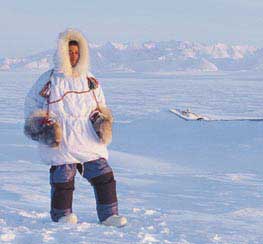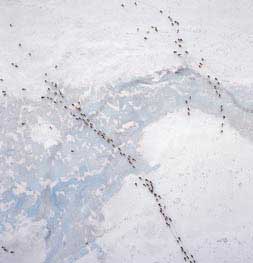Arts
Dancing With The Bears

The Arctic chill has turned hot for Subhankar Banerjee.
|
Sometimes a story is so amazing that you want to give it three beginnings – if that were possible. Let’s try. *Subhankar Banerjee, armed with a camera, spent 14 months traveling 3,000 miles on foot and by snowmobile in the Arctic icebox, with temperatures below -40 degrees F. with wind chills of 60 mph. He ate moose, caribou and whale meat and nearly lost his toes to frost bite. He used up all his savings, including his 401Ks, to finance this trip.
*Having never ever published even one photo, Subhankar Banerjee suddenly had a book contract for his images; President Jimmy Carter wrote the introduction to his book and famous names in conservation wrote the essays; and to top it all, the prestigious Smithsonian National Museum of Natural History mounted a solo exhibition of his work. *Can a book become a political football between Conservationists and the proponents of oil drilling in the Arctic Refuge? After Senator Barbara Boxer held up Subhankar Banerjee’s book on the Senate floor to rally opposition to oil exploration, the Smithsonian pedaled backwards on its commitment to the show, stirring up a national hullabaloo covered in every major media. There you have it – all the high drama of a simple Calcuttan’s life! And to think that all Banerjee had wanted to do was shoot images of polar bears in their natural habitat. The first venture of this unknown photographer into the Arctic National Wildlife certainly snowballed into something far bigger than the Arctic he was exploring. It also changed his life. Banerjee, 36, was born in Bahrampure near Calcutta. As a child, he did not shoot pictures with the mandatory Brownie camera – his passion was painting, inspired by a grand uncle who was a noted artist. He recalls, “I wanted to pursue painting seriously, but having grown up in a middle income family, you don’t really become a painter and make a living of that. So I pursued the path of science.” After receiving a bachelor’s degree in electrical engineering he moved to the United States where he obtained master’s degrees in physics and computer science. While studying at New Mexico State University, Banerjee fell in love with the wide-open spaces of the Southwest. Always involved in the outdoors, Banerjee pursued his passion for backpacking, mountaineering, skiing and kayaking. He joined the Sierra Club, a large national conservation organization, even as he worked as a scientist, first at Los Alamos National Lab in New Mexico and then at Boeing in Seattle.
Around this time he started shooting pictures and as he recalls, “I picked up a large 35 mm camera – one camera, one lens – just point and shoot. But more than the photography, I fell in love with the outdoors. From that point on I was trying to figure out how I could combine art and outdoors in a career but it took me ten years from that point on to leave my scientific background.” His first quest to photograph polar bears in Churchill, Canada, was a disappointment: there were almost more photographers than bears! Looking for a really remote place, he started communicating with biologists in the Arctic Refuge in Alaska, and found that this was an incredibly remarkable place with a tremendous diversity of wildlife. Indeed, the Arctic National Wildlife Refuge is America’s Serengeti, comprising 19.8 million acres of land in the northeast corner of Alaska with one of the most intact ecosystems with 36 species each of animals and fish, and over 180 species of birds, which converge from six continents. The once endangered muskox also lives here and gives birth to its young on the coastal plain and 300,000 snow geese land here every autumn. It is home to indigenous people who depend on the land for survival. “I started researching how much of it has been actually documented and realized the only documentation that existed was of the summer months,” says Banerjee: “.So I felt this was an opportunity to go up there and document this place during all the seasons, including an extensive winter, which is very harsh up there.” Banerjee went there in March 2001, starting with his own savings for this very expensive project costing over a quarter of a million dollars. He recalls, “I dropped in every penny of my lifetime saving,s which was about $80,000, including my 401Ks.” He was able to raise about $60,000 through foundations and organizations and the book advance, but says he’s over $100,000 in debt. When he first landed in the bone-chilling remote Arctic, which can only be reached by small plane, he panicked. “I’m like, what am I doing here? It’s an extremely harsh place. I thought that I probably wouldn’t survive, forget about photography! But my guide Robert Thompson and his wife Jane started reassuring me that though things would get worse, I would survive. And I did. I started taking baby steps and over a period of time I learned how to live and work there.”
As he traveled the brutal terrain with his Inupiat Indian guide, camping on the coastal plain and exploring the Arctic coast by raft and kayak, Banerjee saw the persistence of life in the harshest of climates, convincing him of the utter necessity of preserving this magnificent wilderness. Even as his images developed, so did his commitment to the land. “During the harsh winter months when the temperature drops to minus 40 F or lower, not only does life thrive here, but new life is born. Some of my most powerful photographs were taken during the winter months in the hrefuge.” These images speak for themselves: a tiny Buff-breasted Sandpiper defiantly dancing in the snow, finding water even at 40 degrees below zero; the tracks of a polar bear and her cubs shown in relief on the snow; moose foraging for food in a snow-covered world which has always given it sustenance; and yes, images of an Inupiat Eskimo cemetery with whalebone monuments, testimony to a way of life which may fast disappear. Not surprisingly, these dramatic images and Banerjee’s utter belief in his work started to open doors. He got a book contract from The Mountaineer Books for Refuge: Seasons of Life and Land (Seattle, 2003) which has 120 images by Banerjee besides eight essays on his experiences. Along the way, his commitment won him the support of noted conservationists like Jane Goodall and Robert Redford. Six of the most illustrious conservationists wrote essays for the book and President Jimmy Carter wrote the introduction. Recalls Banerjee: “It was remarkable. Everyone that I approached, they believed in my work and joined forces. It was really the story of a dream come true.” His project won the support of The Alaska Wilderness League, The National Audubon Society, and the Natural Resources Defense Council, National Geographic Adventure†and the Blue Earth Alliance. He was also awarded the prestigious Alaska Conservation Foundation Daniel Housberg Wilderness Image Award. The 48-image exhibition of Banerjee’s photographs, which was sponsored and designed by Smithsonian National Museum of Natural History, can be seen till September 2, 2003, albeit in a more low-key way. Whether from political pressure or a reluctance to put on an advocacy show, the Smithsonian has distanced itself by moving the show to the basement rather than in the rotunda, and by abbreviating the descriptive captions on the images. Banerjee believes there was a change of heart for the Smithsonian as the political pressure built up. “After Senator Boxer held up the book, used it in a floor debate and urged her colleagues to go see the exhibit, it happened. There was pressure to cancel the show, but they saved the show and made all these changes to the show.” Indeed, there was a hue and cry and even a Senate hearing. Yet, in a strange way, the controversy has actually helped the cause of conservation by giving it a media spotlight. Says Banerjee, “As you’re aware, the story came out in every major publication so it has given a tremendous amount of visibility for the exhibit, for my work and for the Refuge that none of us would have imagined.” Although it is not clear now whether the Smithsonian will do a traveling show, Banerjee does have a commitment from the Museum of Natural History in New York to open the show in November. He says, “This is a museum that I wouldn’t want to miss out, it takes 3 or 4 years to schedule any show in that museum. And they have communicated that they want long, descriptive texts on science and ecology too.” Has documenting endangered ecosystems become a mission for Banerjee? “This is what I will be doing for the rest of my life hopefully.” Although he is committed to traveling to the Arctic Refuge, which he has grown to love, he plans next to examine India’s forgotten places. “I’d like to look at more complex issues of land management because India has some of the most bio-diverse places on our planet, second only to the African continent or South America, yet very little knowledge of that exists.”
Did he have any regrets about leaving the financial security of his job? “Not at all. This is something I have been dreaming of for ten years. This is not even something I had to even had to think about. It was already decided that this is the path I am following.” Yes, life has changed for Banerjee. After all, who can remain the same after seeing the Red Northern light in the sky? He recalls of this celestial display, “It was so intense that people saw it all the way in Alabama, Georgia, and California. They thought it was a terrorist attack!” Such unspoiled beauty and the privilege of documenting it has given Banerjee a new perspective on life. “I was extremely lucky to be at the right place at the right time. It has made me very humble and appreciate the simple things in life.” Currently Banerjee is on a lecture tour, which will take him to Chicago, Berkeley, San Francisco and New York during the month of June. He will spend the year traveling and speaking, building awareness of conservation. No matter where he goes, one image stays with him, a rare viewing of a mother bear and her cubs. “I am mesmerized at the sight: for the next half hour the bear and her cubs play on the bank, running, nuzzling, sharing moments of affection, before returning to the den. That evening the blizzard picks up again, with strong winds blowing snow across the flat delta. The next day we find the den covered with snow with no visible tracks to tell us whether the bears have already left the den for the sea ice.” In spite of camping out in blizzard conditions for the next 29 days, Subhankar Banerjee never saw the bears again. He would like to ensure that the world continues to see them. |





You must be logged in to post a comment Login